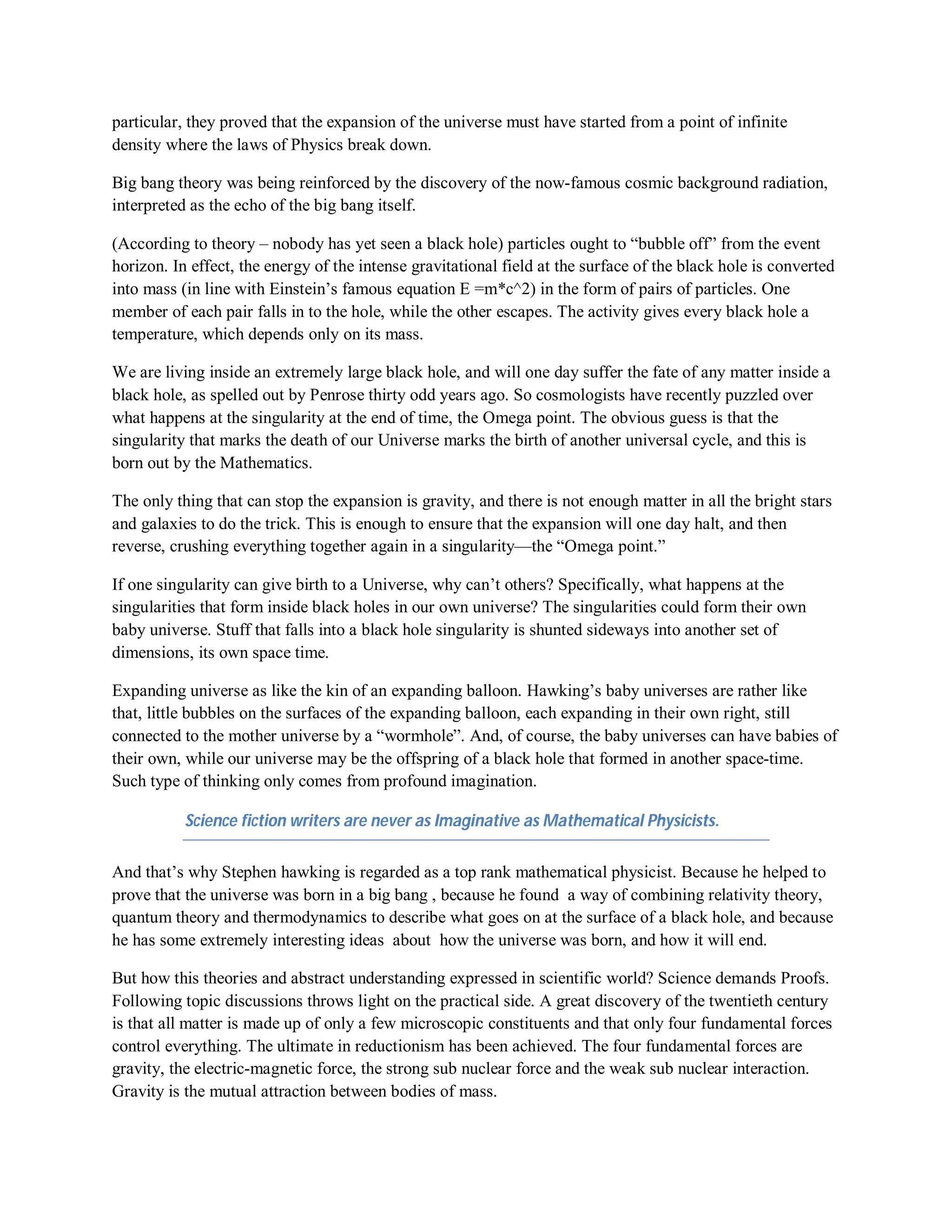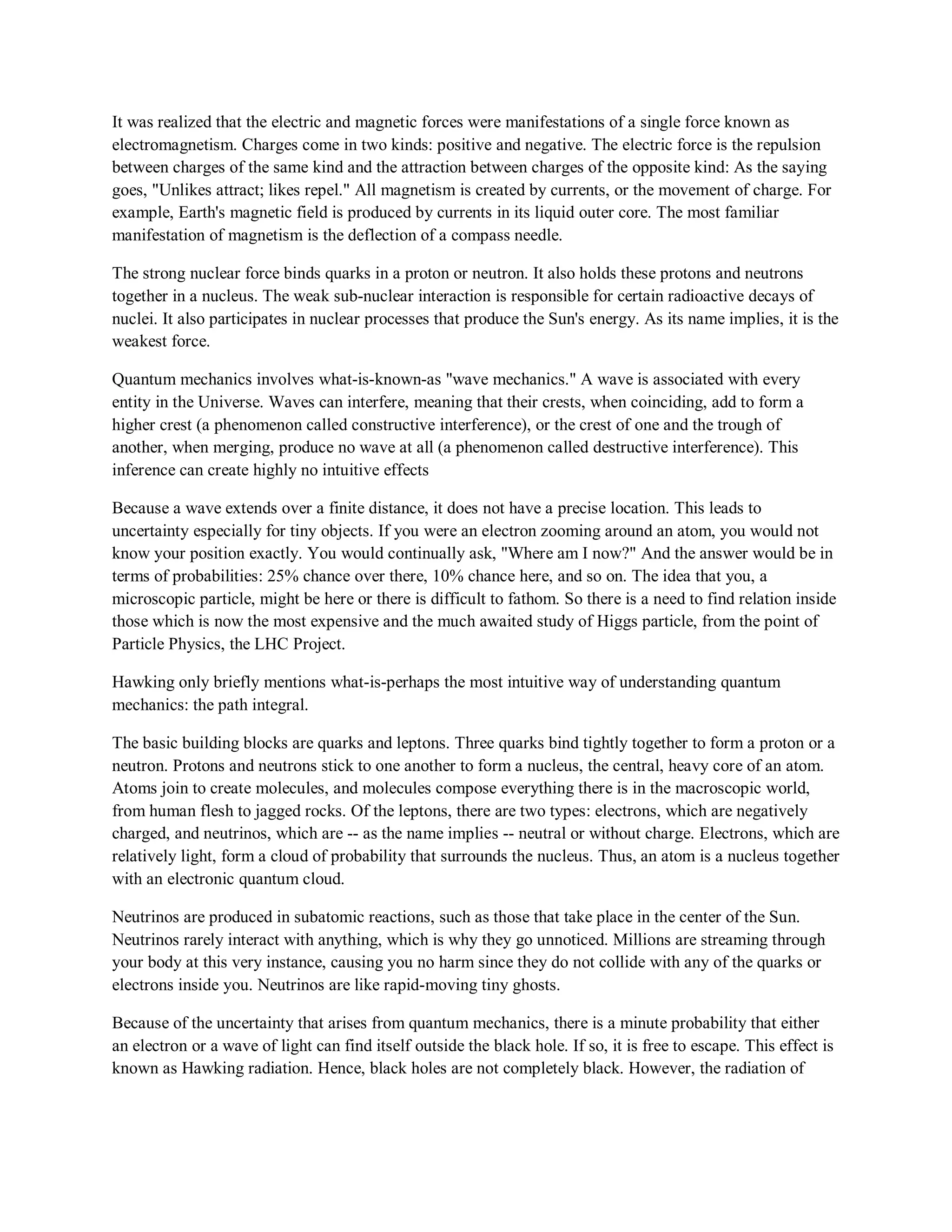- The document discusses the Big Bang theory of the origin and expansion of the universe, and the search for the Higgs boson particle through experiments at the Large Hadron Collider.
- It explains that the Big Bang originated from a point of infinite density where the laws of physics break down, and that black holes may give birth to "baby universes" through singularities.
- The document highlights how particle physics experiments like those at the LHC aim to understand the fundamental forces and particles that make up the universe, such as the still-hypothetical Higgs boson particle.
![“MISSING HIGGS: BIGBANG & PARTICLE STUDY”
PUSHKAR SUNIL PUROHIT
[S.Y.BSC Physics]
ADITYA SANJAY DALAL
[S.Y.BSC Physics]
PREFACE
We all are always bounded by the thoughts & the questions about the origin of Universe.
The unsolved & unexplained; the solutions to all such questions lies in understanding the expansion of
Universe and the origin of Universe i.e. Big Bang. The article tries to explain the subject in frame of
Physical study of fundamental forces and the context of the above the main topic of interest,
understanding of LHC & of finding the Missing Higg’s particle.
Consider the following chain of questions. [1] What causes Earth's motion? The answer is, of course,
gravity. The Sun pulls on Earth causing it to orbit in an almost perfect circle. [2] But what causes gravity?
According to Albert Einstein's general theory of relativity, it is the curvature of space. [3] But what causes
space to curve? Again, according to Einstein's theory, it is mass. [4] But why should mass cause space to
deform? At this point, scientists can only say, "This is the way things are."
The idea that the universe was born in a singular event called the Big Bang, at a definite moment in time
some 15 billion years ago. From then, the Universe is expanding.
An amazing consequence of gravity theory is the expansion of the Universe. The fabric of space is
stretching, causing its contents to drift apart. We, humans, do not see the expansion because its local
effect is insignificant. One needs to look at distance objects. When astronomers view faraway galaxies,
they see them all moving away from Earth and away from one another.
Mathematical physicists also toyed with another great idea that they could not prove had any direct
relevance to the universe we live in. this was the concept of what are known as black holes—they were
only given the name in 1969.According to the best laws of physics we know (Einstein’s general theory of
relativity), any dead star with more than about three times as much matter as there is in our sun must
collapse under its own weight , shrinking down literally to a mathematical point , a singularity. Living
stars do not do this, because the heat generated in the interiors provides the pressure needed to hold them
up against the inward pull of gravity. On its way to a singularity, the collapsing star becomes so dense
that the gravitational pull at its surface becomes so strong that nothing, not even light can escape. It
disappears inside what is known as “Event horizon.”
Roger Penrose proved that all the matter inside a black hole must collapse into the singular point, a point
of infinite density at which the laws of physics break down. Collapsing things must form singularities,
according to Penrose’s work; now, the found that expanding things must come from singularities. In](https://image.slidesharecdn.com/c4b19be8-f3cb-4bfa-9720-ffcb8f9c749b-160108203352/75/MISSING-HIGGS-BIGBANG-PARTICLE-STUDY-1-2048.jpg)


![electrons and light emerging from a black hole is extremely feeble unless the black hole is of microscopic
size. This is because quantum mechanical effects are only significant for tiny object
If the Universe is expanding now, then in the remote past, it must have been considerably smaller. About
15 billion years ago, all matter had to have been concentrated in a tiny place. If so, it is possible that the
Universe began as a black hole in which space and time were on equal footing.
The laws of physics determine how the Universe evolves. But they do not specify the initial conditions,
that is, the position of each point of space at the moment of creation.
Hawking in work with Jim Hartle believes that our Universe began with no boundary, a possibility that
can arise only if space and time are on equal footing. But as discussed above, right from molecular
interaction to subatomic interaction, there is a need to understand interaction beyond this, which is the
search for the so called “God Particles” i.e. the Higgs Particles from the famous LHC [Large Hadron
Collider] project of CERN at Geneva.
MISSING HIGGS
A major breakthrough in particle physics came in the 1970s when physicists realized that there are very
close ties between two of the four fundamental forces – namely, the weak force and the electromagnetic
force. The two forces can be described within the same theory, which forms the basis of the Standard
Model. This ‘unification’ implies that electricity, magnetism, light and some types of radioactivity are all
manifestations of a single underlying force called, unsurprisingly, the electroweak force. But in order for
this unification to work mathematically, it requires that the force-carrying particles have no mass. We
know from experiments that this is not true, so physicists Peter Higgs, Robert Brout and François Englert
came up with a solution to solve this conundrum.
“They suggested that all particles had no mass just after the Big Bang. As the Universe cooled and the
temperature fell below a critical value, an invisible force field called the ‘Higgs field’ was formed together
with the associated ‘Higgs boson’. The field prevails throughout the cosmos: any particles that interact
with it are given a mass via the Higgs boson. The more they interact, the heavier they become, whereas
particles that never interact are left with no mass at all. “
This idea provided a satisfactory solution and fitted well with established theories and phenomena. The
problem is that no one has ever observed the Higgs boson in an experiment to confirm the theory. Finding
this particle would give an insight into why particles have certain mass, and help to develop subsequent
physics. The technical problem is that we do not know the mass of the Higgs boson itself, which makes it
more difficult to identify. Physicists have to look for it by systematically searching a range of mass within
which it is predicted to exist. The yet unexplored range is accessible using the Large Hadron Collider,
which will determine the existence of the Higgs boson.
BUT WHAT IS HIGGS PARTICLE?
The Higgs boson is a hypothetical elementary particle predicted by the Standard Model (SM) of particle
physics. It belongs to a class of subatomic particles known as bosons, characterized by an integer value of
their spin quantum number. Higgs field is a quantum field with a non-zero value that fills all of space, and](https://image.slidesharecdn.com/c4b19be8-f3cb-4bfa-9720-ffcb8f9c749b-160108203352/75/MISSING-HIGGS-BIGBANG-PARTICLE-STUDY-4-2048.jpg)
![explains why fundamental particles such as quarks and electrons have mass. The Higgs boson is an
excitation of the Higgs field above its ground state.
The existence of the Higgs boson is predicted by the Standard Model to explain how spontaneous
breaking of electroweak symmetry (the Higgs mechanism) takes place in nature, which in turn explains
why other elementary particles have mass. As it is the only elementary particle predicted by the Standard
Model that has not yet been observed in particle physics experiments. The Standard Model completely
fixes the properties of the Higgs boson, except for its mass. It is expected to have no spin and no electric
or color charge, and it interacts with other particles through weak interaction and Yukawa interactions.
Alternative sources of the Higgs mechanism that do not need the Higgs boson are also possible and would
be considered if the existence of the Higgs boson were ruled out. They are known as Higgsless models.
EXPERIMENTS AT THE CERN’S LARGE HADRON COLLIDER PROJECT, GENEVA
Experiments to find out whether the Higgs boson exists are currently being performed using the Large
Hadron Collider (LHC) at CERN, and were performed at Fermilab's Tevatron. Mathematical consistency
of the Standard Model requires that any mechanism capable of generating the masses of elementary
particles become visible at energies above 1.4 TeV;[3] therefore, the LHC (designed to collide two 7-TeV
proton beams) is expected to be able to answer the question of whether or not the Higgs boson actually
exists. The two main experiments at the LHC (ATLAS and CMS) both reported independently that their
data hints at a possibility the Higgs may exist with a mass around 125 GeV/c2 (about 133 proton masses,
on the order of 10−25 kg). They also reported that the original range under investigation has been
narrowed down considerably and that a mass outside approximately 115–130 GeV/c2 is almost ruled out.
No conclusive answer yet exists, although it is expected that the LHC will provide sufficient data by the
end of 2012 for a definite answer.
THE STANDARD MODEL & THE EXTENSION
A one-loop Feynman diagram of the first-order correction to the Higgs mass. The Higgs boson couples
strongly to the top quark so it might decay into top–anti-top quark pairs if it were heavy enough.
The Standard Model predicts the existence of a field (called the Higgs field) which has a non-zero
amplitude in its ground state; i.e. a non-zero vacuum expectation value. The existence of this non-zero
vacuum expectation spontaneously breaks electroweak gauge symmetry which in turn gives rise to the
Higgs mechanism. It is the simplest process capable of giving mass to the gauge bosons while remaining
compatible with gauge theories. The field can be pictured as a pool of molasses that "sticks" to the
otherwise mass less fundamental particles that travel through the field, converting them into particles with
mass that form (for example) the components of atoms. Its quantum would be a scalar boson, known as
the Higgs boson.
The quantum of the remaining neutral component corresponds to (and is theoretically realized as) the
massive Higgs boson. Since the Higgs field is a scalar field, the Higgs boson has no spin. The Higgs
boson is also its own antiparticle and is CP-even, and has zero electric and color charge
The Standard Model does not predict the mass of the Higgs boson.[citation needed] If that mass is
between 115 and 180 GeV/c2, then the Standard Model can be valid at energy scales all the way up to the
Planck scale (1016 TeV).The highest possible mass scale allowed for the Higgs boson (or some other](https://image.slidesharecdn.com/c4b19be8-f3cb-4bfa-9720-ffcb8f9c749b-160108203352/75/MISSING-HIGGS-BIGBANG-PARTICLE-STUDY-5-2048.jpg)
![electroweak symmetry breaking mechanism) is 1.4 TeV; beyond this point, the Standard Model becomes
inconsistent without such a mechanism, because unitarily is violated in certain scattering processes.
Extensions to the Standard Model including super symmetry (SUSY) predict the existence of families of
Higgs bosons, rather than the one Higgs particle of the Standard Model. Higgs mechanism yields the
smallest number of Higgs bosons; there are two Higgs doublets, leading to the existence of a quintet of
scalar particles. Many super symmetric models predict that the lightest Higgs boson will have a mass only
slightly above the current experimental limits, at around 120 GeV/c2 or less.
“If it turns out that we cannot find it, this will leave the field wide open for Physicists
to develop a completely new theory to explain the origin of particle mass.”
References
1. Case Study of “A Brief History of Time” by Stephen Hawking.
- From the Big Bang to the Black holes.
2. With references from reviews and articles by Bantum, Jupiter Scientific
3. Free Public License Information source - Wikipedia.org [the free encyclopedia]](https://image.slidesharecdn.com/c4b19be8-f3cb-4bfa-9720-ffcb8f9c749b-160108203352/75/MISSING-HIGGS-BIGBANG-PARTICLE-STUDY-6-2048.jpg)